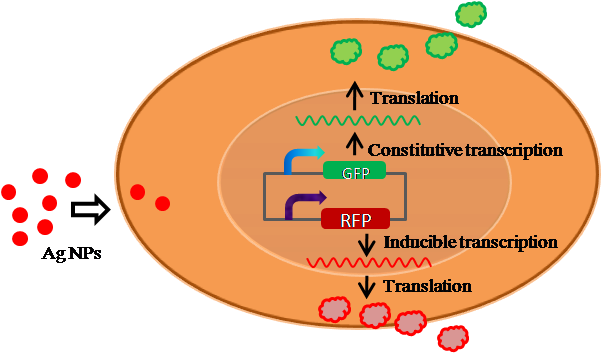With the expanding use of engineered nanoparticles (NPs), nanomaterial toxicity is becoming an increasingly important issue in nanotechnology. In the interests of biosecurity, it is important to develop a high-throughput and sensitive method to evaluate NP safety.
Given this, a study team led by Prof. WU Lijun in Institute of Technical Biology & Agriculture Engineering, Hefei Institutes of Physical Science (CAHIPS), developed cell-based biosensors to efficiently monitor nanoparticletoxicity. The study entitled Development of dual-fluorescence cell-based biosensors for detecting the influence of environmental factors on nanoparticle toxicity was published in Chemosphere.
In the study, three cell-based biosensors were developed to efficiently and conveniently monitor NP toxicity. The biosensor cells were obtained by transiently transfecting human cells with biosensor plasmids, which contains a mCherry gene regulated by an inducible promoter [an activator protein 1 (AP-1) promoter, an interleukin 8 (IL8) promoter, or a B cell translocation gene 2 (BTG2) promoter], with an enhanced green-fluorescent protein gene driven by the cytomegalovirus promoter as the internal control. After optimizing flow cytometric analysis, these dual-fluorescence cell-based biosensors possess the capability to accurately and rapidly detect NP toxicity.
Researchers found that the responses of AP-1, BTG2, and IL8 biosensors in assessing the toxicity of silver nanoparticles (Ag NPs) showed good dose-related increases after exposure to Ag NPs and were consistent with data acquired by conventional assays, such as western blot, real-time polymerase chain reaction, and immunofluorescence.
In addition, further investigation of the effects of environmental factors on Ag NP toxicity revealed that aging in water, co-exposure with fulvic acid, and irradiation with ultraviolet A light could affect Ag NP-induced biosensor responses.
These findings suggested that novel dual-fluorescence biosensors can be applied to accurate and sensitive monitoring of NP toxicity.
This work was supported by the Major National Scientific Research Projects, the Strategic Leading Science & Technology Program, the Major/Innovative Program of Development Foundation of Hefei Center for Physical Science and Technology, and the CAS/SAFEA International Partnership Program for Creative Research Teams.

Figure 1. Schematic drawing of detecting the toxicity of nanoparticels with the dual-fluorescent biosensor system.
(Image by LIANG Junting)
Contact:
CHEN shaopeng
Institute of Technical Biology and Agriculture Engineering (http://english.itb.cas.cn/)
Hefei, Anhui 230031, P. R. China.
Email: spchen035@ipp.ac.cn
 Tel: +86-551-65591206
Tel: +86-551-65591206
 Fax: +86-551-65591270
Fax: +86-551-65591270
 Emai: zhous@hfcas.ac.cn
Emai: zhous@hfcas.ac.cn
 350 Shushanhu Road
350 Shushanhu Road